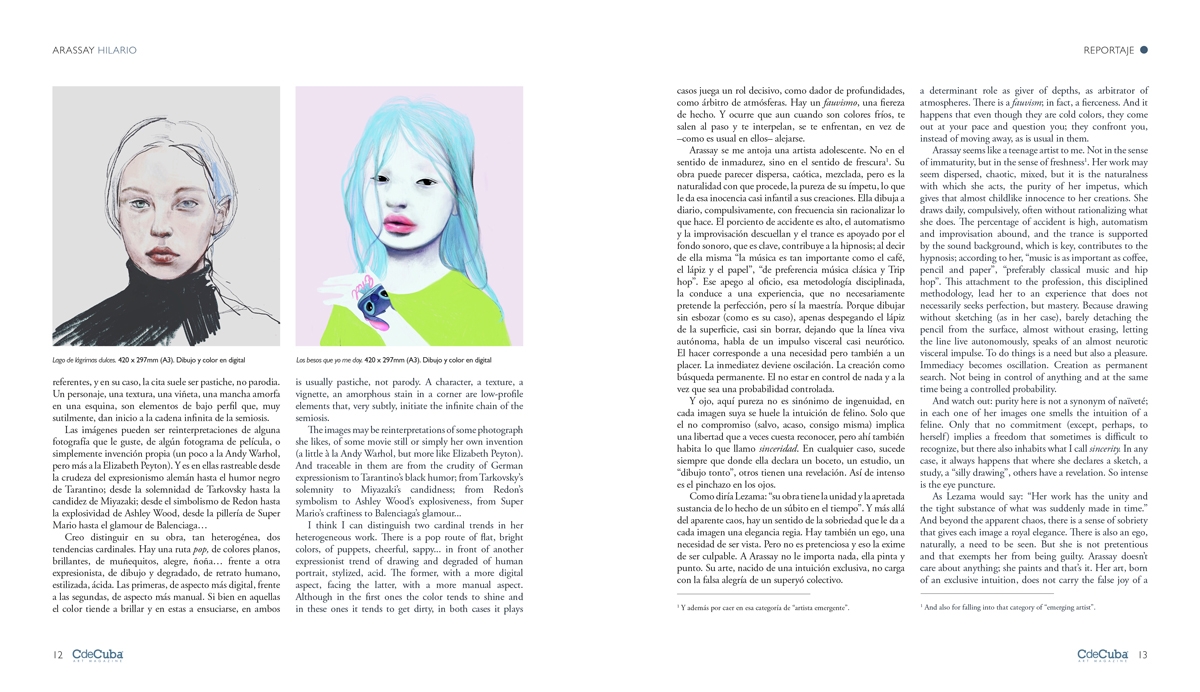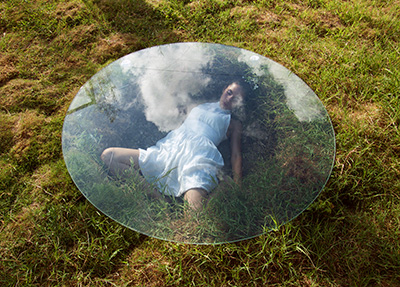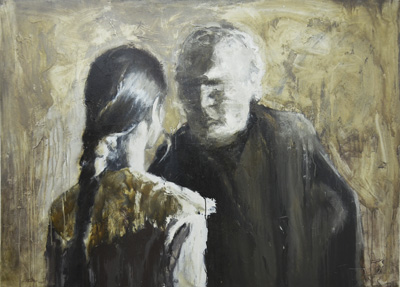[vc_row][vc_column][vc_column_text]
Portrait of the Adolescent Artist
By Magela Garces
There are artists who are liars and artists who are sincere (we could say false and true, but these denominations give me an itch). I will explain.
For Tolstoy, and obviously also for me, one of the characteristics of what he calls «true art» is the ability of the work to cause in the receiver the same impression (emotion) felt by the creator. That is, when the artist truly believes in what he does, when he is consistent with himself, with his convictions, and devotes his entire being to the work, then the work becomes credible, satisfactory, convincing, authentic; in short: sincere. Thus, the piece achieves a power and a metaphorical robustness capable of involving the receiver in a palpitating and dialogical aesthetic experience.
Arassay Hilario belongs to this caste. The rest are the liars.
Another aspect that distinguishes – and this is already a pseudoscientific theory of mine – an authentic creator, even if he does not dedicate himself to art or literature is think poetically, that is, at the level of spoken and written language, the capacity for metaphorical association and the construction of similes. They are individuals with whom to talk, and even more so to chat; it is stimulating because they always say unexpected things. Arassay is one of those. And in her case it extends to the titles of her works and the texts she sometimes season them with when sharing them in Instagram. It is an extra anchorage, a semantic bonus that seduces and fits perfectly.
Arassay’s work does not demand in the first place a painful exegesis. Her spontaneity points more to the palate. However, there is often a wink; the intertextuality shows itself and hides like a hyperkinetic hare. There is purity of spirit, but not of references, and in her case, the quotation is usually pastiche, not parody. A character, a texture, a vignette, an amorphous stain in a corner are low-profile elements that, very subtly, initiate the infinite chain of the semiosis.
The images may be reinterpretations of some photograph she likes, of some movie still or simply her own invention (a little à la Andy Warhol, but more like Elizabeth Peyton). And traceable in them are from the crudity of German expressionism to Tarantino’s black humor; from Tarkovsky’s solemnity to Miyazaki’s candidness; from Redon’s symbolism to Ashley Wood’s explosiveness, from Super Mario’s craftiness to Balenciaga’s glamour…
I think I can distinguish two cardinal trends in her heterogeneous work. There is a pop route of flat, bright colors, of puppets, cheerful, sappy… in front of another expressionist trend of drawing and degraded of human portrait, stylized, acid. The former, with a more digital aspect, facing the latter, with a more manual aspect. Although in the first ones the color tends to shine and in these ones it tends to get dirty, in both cases it plays a determinant role as giver of depths, as arbitrator of atmospheres. There is a fauvism; in fact, a fierceness. And it happens that even though they are cold colors, they come out at your pace and question you; they confront you, instead of moving away, as is usual in them.
Arassay seems like a teenage artist to me. Not in the sense of immaturity, but in the sense of freshness. Her work may seem dispersed, chaotic, mixed, but it is the naturalness with which she acts, the purity of her impetus, which gives that almost childlike innocence to her creations. She draws daily, compulsively, often without rationalizing what she does. The percentage of accident is high, automatism and improvisation abound, and the trance is supported by the sound background, which is key, contributes to the hypnosis; according to her, «music is as important as coffee, pencil and paper», «preferably classical music and hip hop». This attachment to the profession, this disciplined methodology, lead her to an experience that does not necessarily seeks perfection, but mastery. Because drawing without sketching (as in her case), barely detaching the pencil from the surface, almost without erasing, letting the line live autonomously, speaks of an almost neurotic visceral impulse. To do things is a need but also a pleasure. Immediacy becomes oscillation. Creation as permanent search. Not being in control of anything and at the same time being a controlled probability.
And watch out: purity here is not a synonym of naïveté; in each one of her images one smells the intuition of a feline. Only that no commitment (except, perhaps, to herself) implies a freedom that sometimes is difficult to recognize, but there also inhabits what I call sincerity. In any case, it always happens that where she declares a sketch, a study, a «silly drawing», others have a revelation. So intense is the eye puncture.
As Lezama would say: «Her work has the unity and the tight substance of what was suddenly made in time.” And beyond the apparent chaos, there is a sense of sobriety that gives each image a royal elegance. There is also an ego, naturally, a need to be seen. But she is not pretentious and that exempts her from being guilty. Arassay doesn’t care about anything; she paints and that’s it. Her art, born of an exclusive intuition, does not carry the false joy of a collective super ego.
However, in spite of the lyricism and delicacy of his compositions, even in the most innocuous one feels an aggressiveness, a certain violence as if from beyond the grave. They are like children’s illustrations for adults in which something dark underlies. The beautiful grotesque. Rawness is sometimes color, sometimes line and other times situation. It is because her pieces are also exorcist exercises, soft demons exteriorized in delirium. And the figures are almost an extension of the artist; they, like Arassay, go in a trance.
The characters are like floating; they are self-sufficient, they need no context. They levitate in an dream vision and sometimes even metamorphose into creatures from another world. They dress in timelessness, which at the same time is contemporary, and they remain. The anecdote flows in spite of the solemnity; they move even if it doesn’t seem so. They are figures who walk forward and precipitate with a severe, circumspect attitude.
The portrait prevails, and that generates intimate warmth, an intimacy of dialogue behind closed doors. And not indefectibly a human portrait, but also of animals, creatures of diverse nature. Hardly any inanimate elements are reproduced.
What Arassay calls «character design» I see as an obsession toward a kind of emotional archetype, a feeling that is a cocktail of feelings and adapts to the container according to the variation in the form. The outward image changes (sometimes not even much), but the spirit is the same.
The recurrence of the Asian faces is a merely visual fetish, beyond any Japanese influence his work may have. Animals, on the other hand, tend to have a more hunchbacked symbolic charge. It is curious, because most of the time, they are usually dogs, cats, bears, rabbits, nice entelechies, friends. But there is a group of very peculiar drawings from the time when Arassay still lived in Cuba that represent scenes with a whole specific narrative, in which the toad stands as aggressive male presence. It is uncommon to find «scenes» in Arassay’s work, and also seldom are there images where sex as theme becomes so explicit and uncomfortable. These drawings are very refined, but quite disturbing.
Fragility and vulnerability are habitual apparitions. The representation of childhood, the delicate bodies (although voluminous, heavy bodies are often to be seen), the faces that hardly smile, emit an aroma of melancholy, of abandonment, as if surrounded by remoteness. They are lonely figures, seldom accompanied, and when they are, the company is often an animal. Man and beast, man and himself, homo homini lupus.
Each image can be a shot of a movie and each one in turn tells a different story. It’s fascinating.
That essential exploration in Arassay becomes tangible in the overwhelming variety of appearances. There are no pauses in her work, perhaps only in terms of visualities. Her universe bursts in systematic, contrasting evaporations. The air of graffiti, very much of trains, very much of walls, very much of my teenager room, but at the same time very much of white cube, very much of museum, very much of aseptic wall. The aura is sometimes present, sometimes absent, like someone who puts on and takes off a jacket. Note that Arassay, although she did not attend the academy, has stopped to study in depth, and drinks from both tradition and contemporariness. She is well aware of the influences she receives. And in addition to illustration and animation, which is what she has performed most, she has also designed wardrobe, backgrounds, and staging. Her versatility is very cosmopolitan, extending to that fashion air where the characters often look like models because of the poses, gestures, and clothes2, and where some images look like advertising material (incidentally, the artist has also collaborated with Benetton). Chameleonic metropolitan art is to be seen even in this mixture of traditional and digital drawing, intertwined in complicity, and in the recurrence of the A3 sheet poster-like format (I have already told her she should try larger dimensions; when she does it, it will be a scandal).
Arassay’s compositions are odd, they are different, and that is refreshing. There is a wisdom that emanates from his work like the smoke of incense. And it is subversive because it twists what it touches. The substance is evident, and her search, at times, becomes crack and echo. This girl creates to the rhythm of a «foreboding melody3.” The prediction is luminous and today (note the date) I affirm and bet with all the letters that the future will be explosive.
[/vc_column_text][/vc_column][/vc_row][vc_row][vc_column][vc_column_text]
[/vc_column_text][/vc_column][/vc_row]





